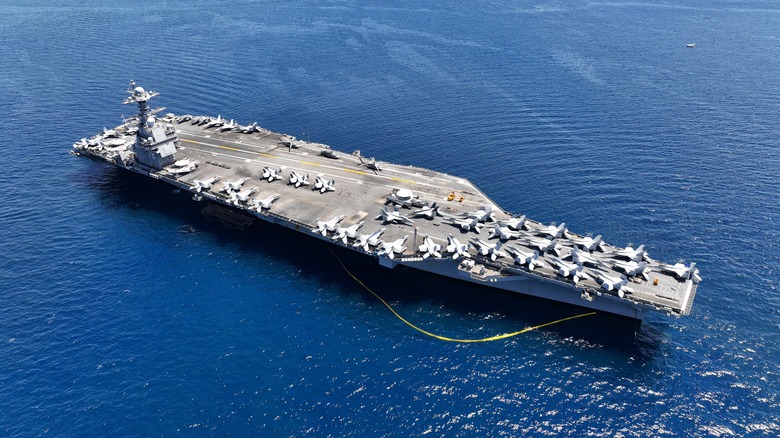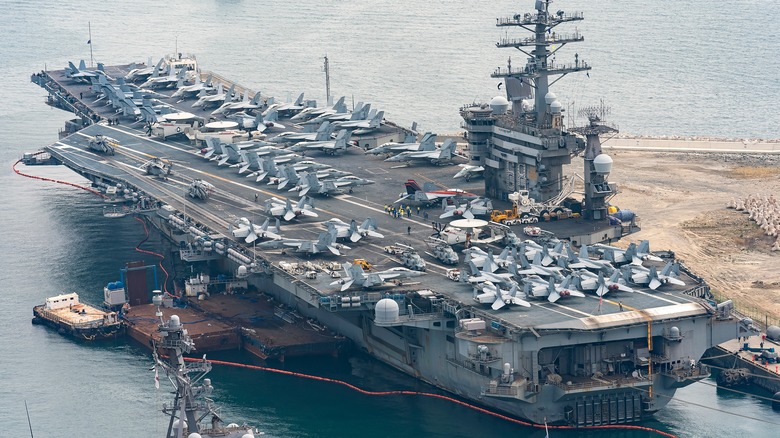How Much Does An Aircraft Carrier Really Cost? Here's What We Know
An aircraft carrier isn't exactly an impulse buy that you find on display at grocery store checkouts, and it's a purchase that's not available to the general public, unlike tanks. But countries can own them, and like having a space program or a nuclear bomb, owning an aircraft carrier, or several of them, is a demonstration of both power and wealth. They're floating airbases that allow countries to project their military might all over the world without having to refuel, so naturally, they're a bit costly. But how much?
The most recent of the U.S. aircraft carriers and the most technically advanced is not surprisingly the most expensive: Commissioned in 2017, the USS Gerald R. Ford (CVN 78) is a $13.32 billion aircraft carrier, according to the Congressional Research Service. That $13 billion price tag comes with many improvements over the previous generation of Nimitz-class carriers, including a larger flight deck, an electromagnetic aircraft launch system (as opposed to steam-driven catapults), and an advanced arresting gear instead of the old hydraulic versions, all of which is expected to increase sorties by 33 percent.
The next of the Ford-class carriers, scheduled to be delivered in July 2025, is the John F. Kennedy (CVN-79), which is projected to cost $12.7 billion. After that the Enterprise (CVN-80) will be $12.8 billion, and the Doris Miller (CVN-81) set at $12.7 billion. A theme is clearly emerging here.
Comparing costs to the Nimitz-class carriers
For their part, the Nimitz-class carriers cost approximately $4.5 billion per unit. While that's a significant difference, the Navy suggests that the carriers in the new Ford class will save more than $5 billion each in ownership costs over the course of their often 50-year service life, which is $32.1 billion for the Nimitz-class ship and $26.8 billion for the USS Gerald R. Ford. Much of this cost relates to maintenance, operations, and personnel, and the systems for the Ford-class carriers are designed to reduce the amount of personnel and require less maintenance. For instance, the USS Gerald R. Ford is the first carrier to feature all electric utilities, replacing steam service lines, which tend to need more upkeep.
Many of the currently serving Nimitz-class carriers are in the process of turning 50, and with the upcoming Ford-class carriers facing delays in production, the Navy regularly has to decide whether to retire a long-serving carrier, as it did with the storied USS Enterprise. Carriers like the USS Nimitz are set for another deployment cycle instead of being retired in 2025 as originally planned, and this may end up being the case for the other Nimitz-class carriers. "Extending Nimitz, extending Ike, it's going to happen for every Nimitz-class carrier. At least one extension," Vice Adm. Kenneth Whitesell said last year, according to Aviation Week.
What's interesting is that decommissioning a carrier and taking it apart is such an elaborate, expensive process that it may sometimes be easier to keep the carrier active, as the reactor has to be dismantled and the nuclear waste carefully transported to a nuclear waste storage facility. There aren't exactly a plethora of companies able to take apart a nuclear aircraft carrier, which may be partially why only three responded to the request to do so for the USS Enterprise.But when you consider their average 50-year lifecycle and the ability to circumnavigate the globe without needing to refuel, it's understandable that deploying them and taking them apart can be a lengthy and costly affair.

